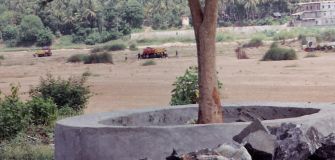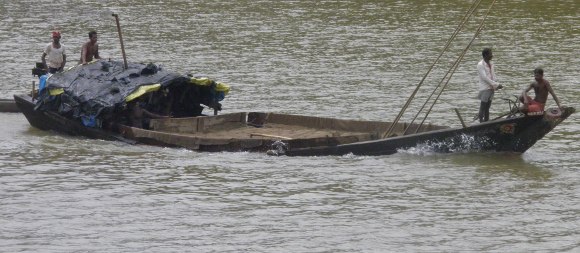We were close to our destination, and the last part of the drive was along riverbed of one the largest rivers of eastern India, the Mahanadi. It was soon after winter and the water had receded substantially, allowing for easy access of bulldozers and trucks to make their way in through a makeshift access just off the main road. At least two truckloads of sand had already been collected and another one seemed to be on its way.
I had no idea whether the sand that was being collected was legal or not, so I asked my co-passenger, a local resident, that question. He seemed to think this was a routine activity. But had no clue that mining of sand, gravel, and boulders across the country had been banned subsequent to the orders of the Supreme Court and National Green Tribunal (NGT).
The smallest of operations now could not be carried out until they took an environment clearance under the Environment Impact Assessment (EIA) Notification, 2006.
I recalled and discussed with him that back in February 2012, the Supreme Court order in Deepak Kumar v. State of Haryana, (2012) 4 SCC 629 required mining of minor minerals (which includes sand) in less than 5 hectares lease area, to seek “environment clearance”.
Subsequently, the NGT’s Principal Bench on 5th August 2013, citing the SC’s judgment, passed a further order restraining removal of minerals from riverbeds across the country until requisite approvals by the Ministry of Environment, Forests and Climate Change (MoEFCC) and the concerned State Level Environment Impact Assessment Authorities (SEIAA). The NGT has been hearing the matter since, petitioners have been threatened and the new interventions have been added in a case which is ongoing.
Just as I was trying to decipher whether the sand collection in the Mahanadi was legal or illegal, my co-passenger remarked. He said, “People have been collecting sand and gravel from the Mahanadi for the longest time, but it is hard to figure out whether they are collecting only what they need for the village needs or more.” What he meant was that once the bulldozer was in the riverbed, who was counting how much sand, is being extracted, even if permissions have been taken.

Trucks collecting sand from a riverbed. Picture: Shailesh D Nair, India Together Files
In this simple observation lies the deeper problem in curtailing and controlling sand mining which has been in the center of political, administrative, social and environmental controversies across the country.
Rise of the cement industry and increase of sand mining
In September 2015, MoEFCC has put out two documents that discuss the impacts of sand mining and then how it can be regulated. The first of these two documents is titled, Guidelines for Sustainable Sand Mining, which clearly acknowledges that while sand and gravel are mined across the world and “account for the largest volume of solid material extracted globally. Formed by erosive processes over thousands of years, they are now being extracted at a rate far greater than their renewal.”
These guidelines indicate that between 47 and 59 billion tonnes of material is mined every year of which sand and gravel, account for both the largest share (from 68% to 85%) and the fastest extraction increase (as compared to other sectors). However, they acknowledge reliable data on their extraction is not available.
The guidelines also attribute the increase in sand mining to the increase requirement and production of cement. The rise of the real estate and building sector in the last decade has been obviously visible with urban spaces spreading way outside the municipal boundaries of the large metropolis as well as smaller towns.
The guidelines note that, “the production of cement is reported by 150 countries and has reached 3.7 billion tonnes in 2012 (USGS, 2013a). For each tonne of cement, the building industry needs about six to seven times more tonnes of sand and gravel (USGS, 2013b). Thus the world’s use of aggregates for concrete can be estimated at 25.9 billion tonnes a year for 2012 alone”.
The guidelines go on to say that the world over cement production has multiplied threefold in the last two decades. The figures quoted from a United States Geological Survey (USGS) document show that there has been an increase in requirement from 1.3 billion tonnes in 1994 to 3.7 billion tonnes in 2012.
In the Ministry’s guidelines the reason for this increase is attributed to the rapid economic growth in Asia, without necessarily acknowledging the role of the international investments and heightened national growth targets. This demand and consumption is only likely to increase in the coming years. India comes second after China in cement production, holding a share of 6.75% with China’s being 58%.
Social and Ecological Impacts
In the same year that the USGS was compiling world statistics, India’s Supreme Court’s order in Deepak Kumar v. State of Haryana, (2012) 4 SCC 629 had made detailed observations on how sand mining was damaging the entire river ecosystem including fish breeding areas, conservation of bird habitats and increasing salinity in the rivers. It had also affected safety of bridges and weakening of the riverbeds.
According to the Geological Survey of India’s guidelines titled, Impacts and Methodology of Systematic and Scientific Mining in the river bed material, there are seven major hazards of sand and gravel extraction. These broadly include the impact on the in-stream flora and fauna and vegetative cover, riverbed erosion, degradation and pollution of groundwater, lowering of groundwater table and degradation of land.
Extracted sand being carried in a boat in Aghanashini River, Uttara Kannada, Karnataka. Pic: Kanchi Kohli
But none of these documents fully assess the social impacts of sand mining.
What happens when there is over-extraction of sand and gravel? In a local context, people from a village may or may not be complicit in the illegality or over-extraction, but are nevertheless impacted. What happens when the groundwater table of a river depletes just as the GSI guidelines warn? How much does it impact the availability of drinking water in an area? Whether the agricultural output or quality is marred if the riverbed mining leads to increasing salinity of the river water which otherwise irrigates the fields adjoining a flood plain? What happens when some people of a village choose to align with what has emerged to be the “sand mafia” and others don’t?
There is much about the impacts of sand mining that has remained unsaid, even as it has emerged an important talking point worldwide.
The Ministry’s Regulatory Formula
In the midst of this conundrum, MoEFCC has proposed its design to regulate sand mining across the country. In a draft notification dated 22nd September 2015, building further on the guidelines, the ministry has proposed how the instances of excessive sand mining will be assessed.

There are two key elements related to survey and approval to the ministry’s draft amendment to the EIA Notification, 2006 which has been issued following the NGT’s directions to the MoEFCC in January 2015.
The first element lays out the institutional arrangement by which proposals for sand mining are to be approved. For this, the ministry proposes setting up District Environment Impact Assessment Authorities (DEIAAs) and District Expert Appraisal Committees (DEACs) patterned on the state level institutions which oversee the environmental approval of category B projects as listed in the EIA Notification.
These authorities are now to regulate the approvals and monitor the compliance of mining of “minor minerals”, which have been regarded as Category B2 projects. B2 projects (other than real estate and building projects) are drawn out B projects and don’t require the preparation of an Environment Impact Assessment (EIA) report or public hearings. The approvals are granted with details furnished through a special form. In the case of “minor minerals”, which is what sand is extracted for, a new Form 1M has to be filled and submitted to the DEIAA headed by the District Collector.
However, in the case of sand mining being carried out in clusters of 5 ha and above, the draft amendment has a graded approval process including public consultation of every cluster before they are appraised by the DEAC. For a cluster of mines under 5 ha, the approval is at the district level, between 5-50 ha it is at the state level with the designated SEIAA and above 50 ha, the approval process will lie before the MoEFCC and its expert committees.
The second element of the actions proposed by the ministry is the preparation of a district survey report on sand mining. With the structure proposed, the survey report will mainly collect information on the district land use profile, the geology and mineral profile and list of mining leases operational, drainage profile of the rivers flowing in the district and the amount of sand is extracted on record. The current profile does not have any scope assessing instances of illegal mining or its social and environmental impacts.
Such a survey could have been an important opportunity to do full review of the impacts of sand mining which both the executive (bureaucracy) and the judiciary in India have repeatedly acknowledged at least from 2012 onwards. Unfortunately the sub-divisional survey processes leading up to the district survey don’t have any possibility of this review.
There is also no scope envisaged for any public inputs, comments or involvement in carrying out these surveys, from what has been proposed. Given, the long-standing and localized impacts as well as the deep sand mining nexus with local communities, this would have been a good opening to both acknowledge and address the issues at hand.
The problems remain
One of the main problems identified by my co-passenger when we were analyzing the sand mining on the Mahanadi was how can it be determined whether a sand extracting bulldozer and its hirer or owner is extracting just as much sand as approved by whichever authority.
This aspect remains the least detailed out in either of the two documents - Guidelines for Sustainable Sand Mining and the draft amendment- put out by the ministry. The issuance, recording and checking of transit permits are the primary mechanism envisaged so far. The monitoring of conditions remains the responsibility of the district collector, pollution control boards, MoEFCC or any other agency nominated by the ministry. This section yet again does not reflect on the long-standing problems of monitoring and compliance, which have been brought to the attention to the Ministry.
The findings of two studies are of relevance here as much as it is for other sectors regulated by India’s environmental laws.
The first is a national level assessment highlighting the unaddressed aspects of drafting environmental conditions and ensuring their compliance. The second are the findings of a community led ground truthing exercise in Mundra (Kutch, Gujarat), which highlights the livelihood impacts of non-compliance and attempts to build a case for the involvement of affected communities in monitoring environmental compliance.
While the attention an unregulated sector like sand and gravel mining has received is welcome, the remedial steps being taken don’t give the confidence that the issues are going to be resolved soon.
There is no reference anywhere on how the demand for sand mining and cement will be curtailed. While the connections between the two are now formally established, they remain, perhaps deliberately, delinked in the solutions offered.
Notes
a. While the Ministry’s Guidelines give reference to three USGS reports, they don’t give full references for the same. Therefore the reference for the contentions made are from the Ministry’s guidelines on sustainable sand mining accessed by the author on 28.8.2015 from here.
b. B category projects after an initial screening can become B1 and B2. B1 are those requiring EIA/Public Hearing and B2 are those which don't.
References
http://www.moef.nic.in/sites/default/files/Sand%20Mining%20Guideline%2028.08.2015.pdf
http://www.portal.gsi.gov.in/gsiDoc/pub/riverbed_mining_guidelines.pdf
























